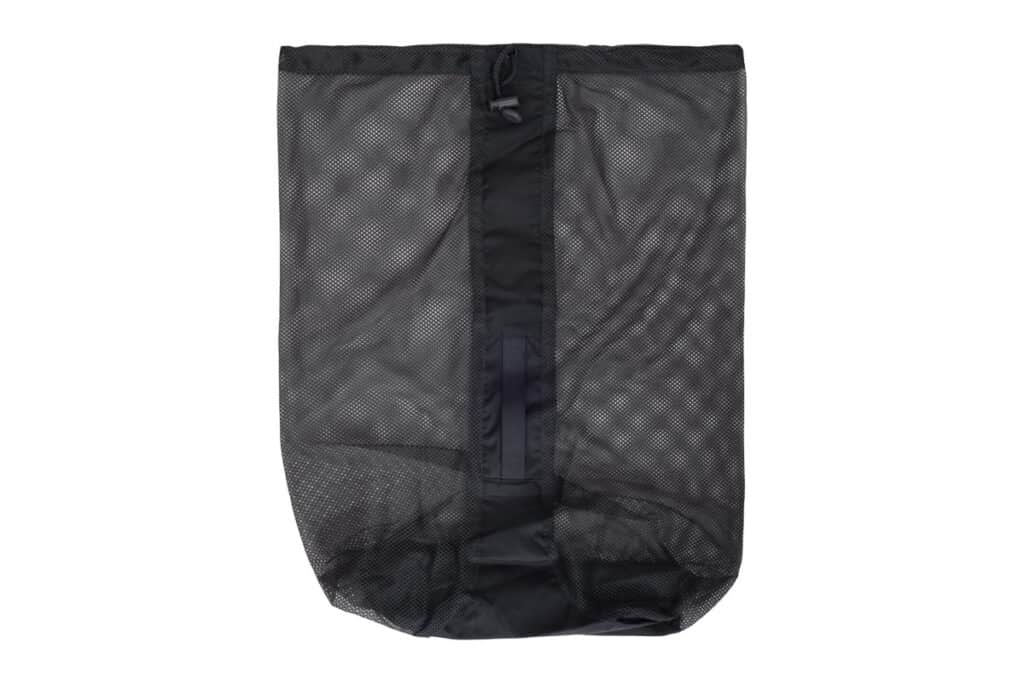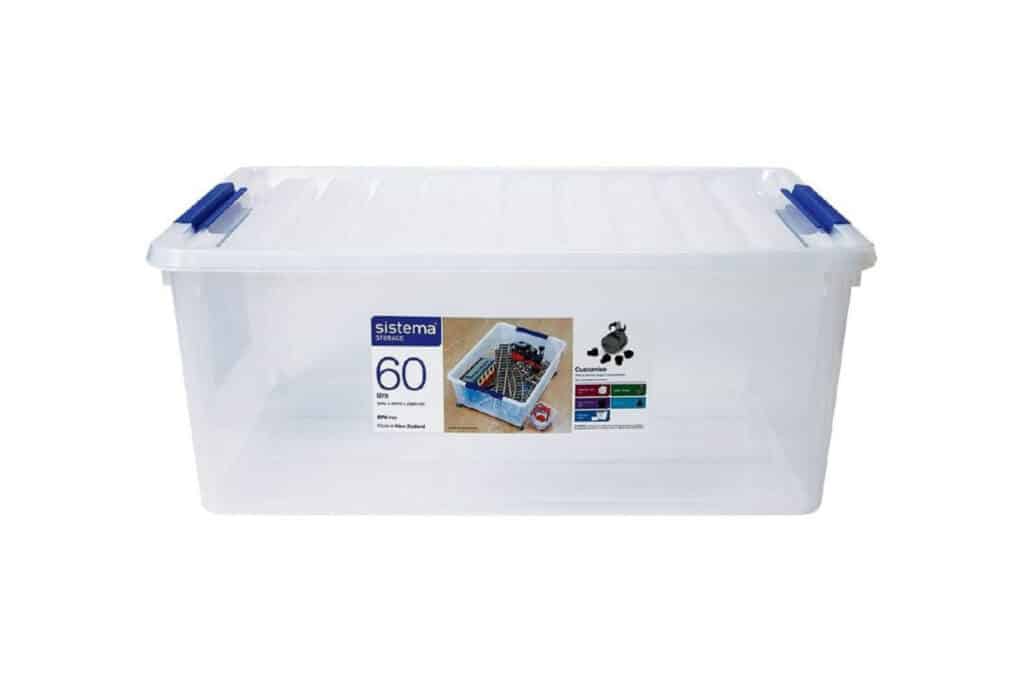Long White Gypsy uses affiliate links and is a member of the Amazon Services LLC Associates Program. If you make a purchase using one of these links, I may receive a small commission at no extra cost to you. See my Privacy Policy for more information.
Keeping your sleeping bag in good condition is essential to prolonging its life and ensuring that you get the best night’s sleep possible. Whether you’re an avid camper or just a weekend warrior, storing your sleeping bag correctly will make all the difference between a restful night of sleep and one filled with discomfort.
In this post, I will discuss how to store a sleeping bag when you return home from a trip, including what materials and tools are needed, as well as step-by-step instructions on how to do it.
I’ve owned sleeping bags since I first started camping over three decades ago, and I’ve learned more than a few lessons in that time about how to take care of your most important piece of gear! I’ve used both types over the years, so you can trust that I’ve learned how to store a down sleeping bag and how to store synthetic sleeping bags from plenty of trial and error!
With my help and advice, you can ensure that your sleeping bag (or quilt!) stays in top condition for years of comfortable camping both on the trails and those weekend camping trips!
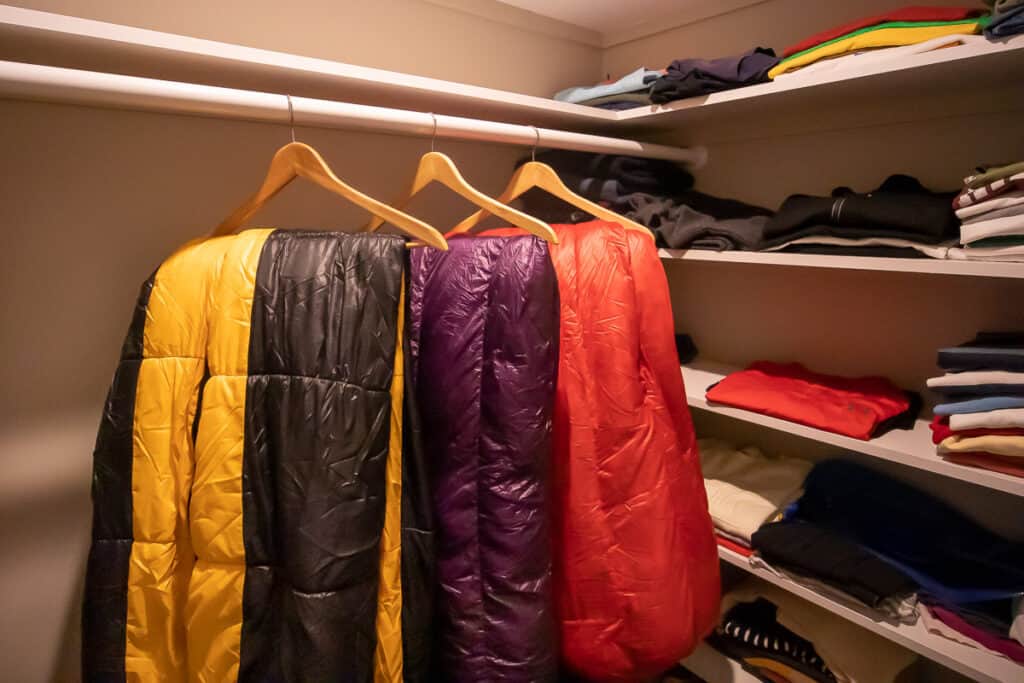
My Picks – The Best Sleeping Bag Storage Bags!
✔️ 100% breathable cotton
✔️ Long and narrow to fit most sleeping bags.
How To Store A Sleeping Bag.
Storing a sleeping bag properly is essential to maintaining its quality and ensuring that you get a comfortable night’s sleep.
An incorrectly stored sleeping bag can easily become soiled or damaged, and over time the fragile insulation fibres inside (whether down or synthetic) will be damaged, leading to a cold night’s sleep.
To avoid this, here is my step-by-step guide on how to store a sleeping bag properly at home.
Step-By-Step Guide: How to Store A Sleeping Bag
Step 1: Clean Your Sleeping Bag
Before storing or compressing your sleeping bag, it’s important to give it a thorough cleaning.
Natural body oils as well as dirt and grime can build up on the outer fabric of your bag over time, but also can accumulate on the insulation fibres themselves. This reduces the efficacy of your bag and can result in a cold night’s sleep.
Keep on top of it by doing a spot-clean of your bag after every trip.
Start by wiping away any dirt or debris from the exterior of the sleeping bag with a soft toothbrush or slightly damp cloth.
Next, turn your sleeping bag inside out and use a dedicated technical soap to spot clean any stains or dirt marks. Make a slightly diluted mixture of the soap in a small dish and use a soft toothbrush to gently agitate the stains.
🔥 HOT TIP 🔥
Pull the outer fabric away from the insulation whilst spot cleaning this to avoid getting the insulation fibres wet and damaging them.
Every few years (or at the end of every season if you use your bag frequently) you may need to do a full wash of your sleeping bag. Check out my detailed instructions on how to wash a sleeping bag (coming soon!) for more.
Once done, wring out the excess moisture and hang up your sleeping bag to air dry completely before preparing it for storage!
Step 2: Air Your Sleeping Bag
Once your sleeping bag is clean and completely dry it’s important to air out the insulation material. This helps prevent unpleasant odours, but also helps to maintain the loft of the down or synthetic fill, which will help keep you warm and cosy at night!
To do this, unzip your sleeping bag completely and let it hang in a cool, dry place for at least 4 to 6 hours.
🔥 HOT TIP 🔥
When airing your bag, turn it inside out for a few hours first before turning it back right way out. This will help your bag to dry evenly and thoroughly.

Always make sure to hang it somewhere out of direct sunlight as UV rays can damage the fragile exterior coating and materials on your bag.
If you’re airing your sleeping bag inside, find a place which isn’t too hot or humid. Hot water cupboards are not the best place, because the warm air can damage the bag over time. Instead, hang your bag over a clothes airer in a dry room and use a household fan to keep the air moving around your bag.
Step 3: Store Your Sleeping Bag
To get the most effectiveness out of your sleeping bag, it’s important to avoid crushing the delicate insulating fibres while the bag is in storage.
This applies not only to down insulation, where feathers can easily be broken or damaged by excessive periods of compression, but also to synthetic fibres which can easily break or flatten making them useless for warmth.
Allowing your sleeping bag to fully loft (fluff up) whilst it’s being stored for lengthy periods keeps a protective layer of air around the delicate insulation materials.
For best results, use one of the following sleeping bag storage hacks to maintain loft and extend the longevity of your bag:
- hang your sleeping bag from a hook in a cool and dry room or cupboard (my preferred method).
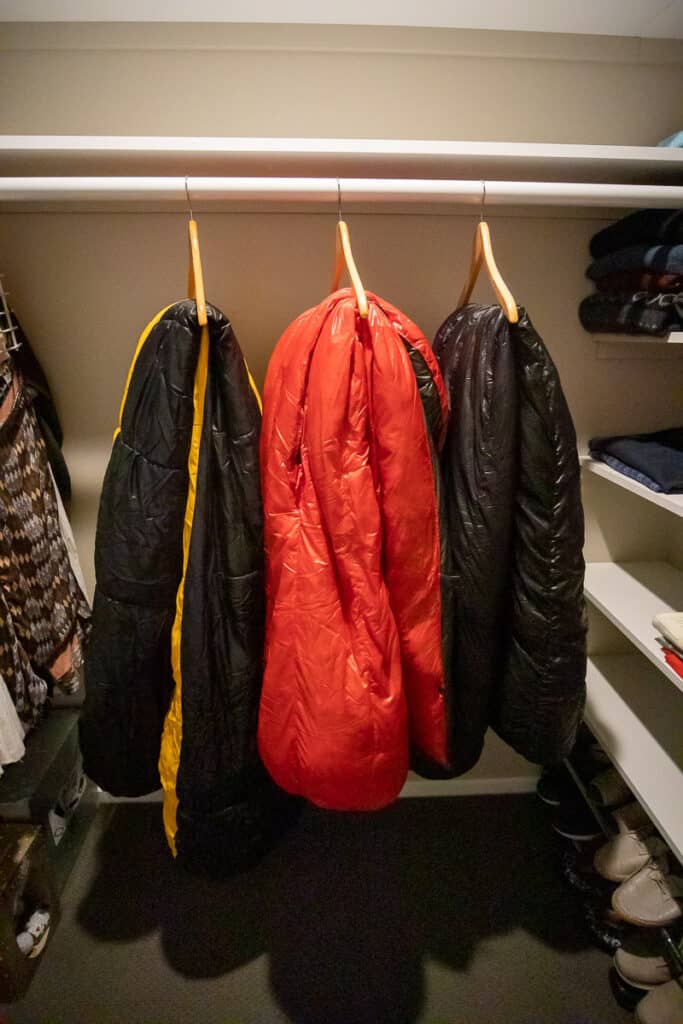
- loosely store your sleeping bag in a large cotton storage sack or mesh bag in the top of a cool cupboard (great for preventing dirt & dust building up on your bag).

- loosely pack your sleeping bag into a large pillowcase or duvet cover and store it in the top of a cool cupboard (a great budget option).
Many sleeping bags sold these days come with their own cotton sleeping bag storage sack, so make sure to use this where supplied.
🔥 HOT TIP 🔥
Undo the zips and turn your sleeping bag inside out before storing – many bags are coated with a waterproof film which creates a vapour barrier and prevents damp air inside the bag from escaping.
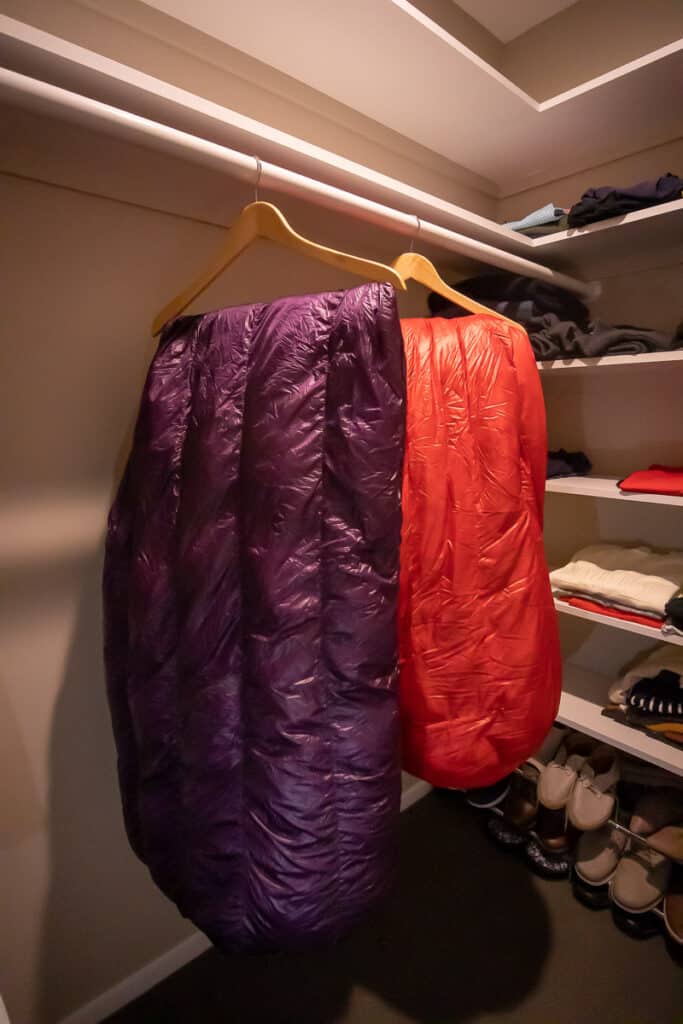
Avoid storing your sleeping bag in hot water cupboards or in direct sunlight, as excessive heat may cause insulation fibres to break and outer fabrics to deteriorate.
How to Compress a Sleeping Bag – Tips On Compression
Wondering is it ok to store sleeping bag in a stuff sack? While compressing a sleeping bag can be an effective way to save space while traveling, it is not ideal for long-term storage.
You should never ever permanently store a sleeping bag by compressing it. Compressing a sleeping bag into a stuff sack should be reserved only for your camping trips or hiking adventures whilst you are moving from place to place.
Compression removes protective air from between the fibres in your sleeping bag, which can cause crushing and breakage of the insulation fibres and reduce the amount of loft available in your sleeping bag. This will ultimately affect its ability to keep you warm at night!
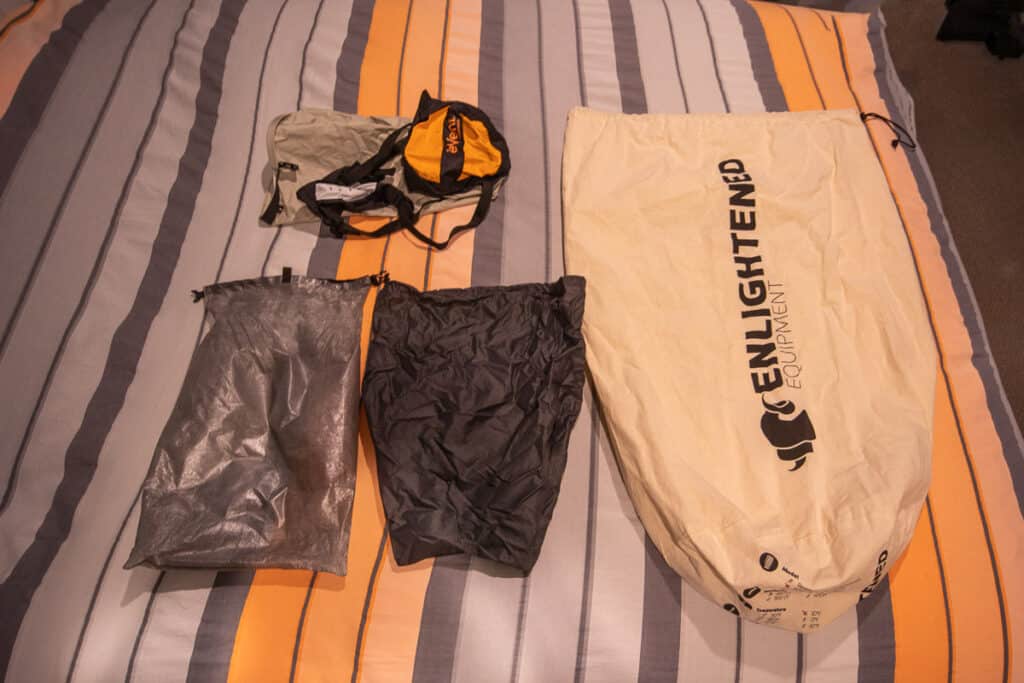
In addition, compressing a sleeping bag can cause the outer fabric to deteriorate and tear, and zips can become bent and buckled.
When you do compress your sleeping bag for travel, you can either roll or stuff sleeping bag into a compression stuff sack. The problem if you roll up sleeping bag into a neat and tight roll before putting it into the sack is that you can compress and damage the fibres even more, as well as end up with lots of dead space.
The preferred option is to start stuffing it foot end first into the sack and let the compression do the hard work.
Always remove your sleeping bag from the compression stuff sack as soon as your arrive at your destination, and allow it to fluff up (loft) fully before you climb into it for the night.
When you return home from your trip, immediately remove your bag from its compression sack and follow the steps outlined in this post for long-term storage.
Where To Store Sleeping Bags.
To prevent damage to the bag and deterioration of the insulating material, it’s best to store sleeping bags in a cool, dry location away from direct sunlight. The best place for a sleeping bag is in a cool and dry room or cupboard where it has plenty of space to fully loft and air out.
Avoid storing your bag in places where temperatures are likely to fluctuate or damp environments.
Both the attic and cellar/basement, are likely to be damp and humid which can cause mould to form on the sleeping bag over time. The same goes for storing your bag in the garage or shed where temperature cannot be regulated.
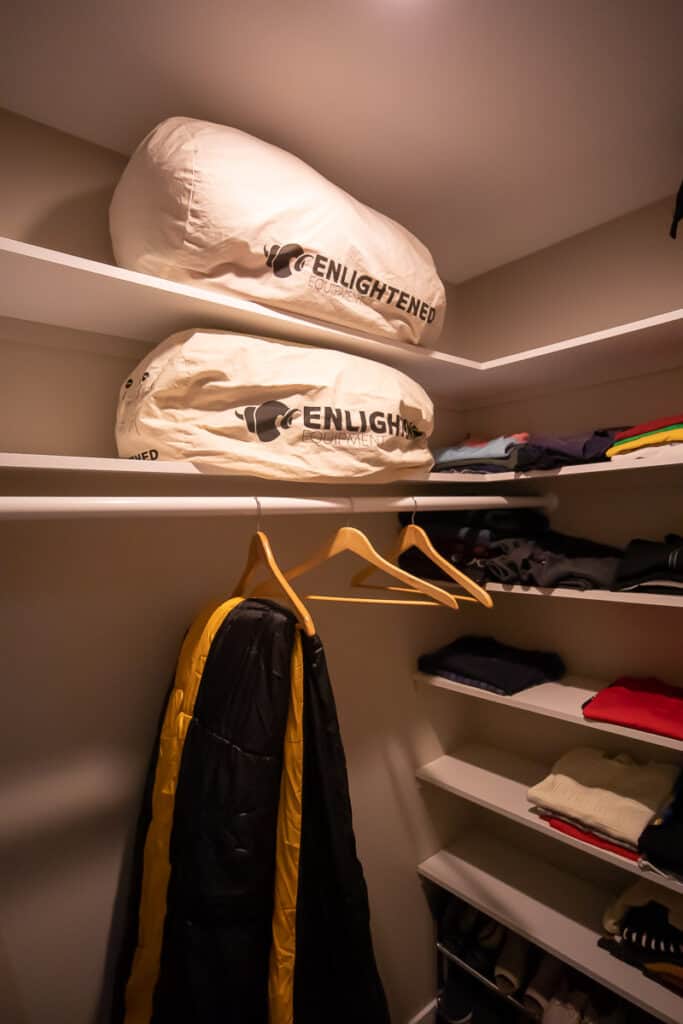
If you absolutely have to store your sleeping bag in an attic, basement or garage, make sure to follow these guidelines:
How To Store Sleeping Bags in Garage
Garages can be damp, and non-insulated garages can have wild temperature fluctuations depending on the season.
Whereas you should avoid storing your sleeping bag in a garage if possible, you can minimise damage to your bag by first following the Step-By-Step guide above to prepare your bag for storage.
🔥 HOT TIP 🔥
You absolutely must make sure you’ve removed all moisture from your bag before storing it in a garage, to prevent the growth of mould.
Loosely pack your sleeping bag into a cotton sleeping bag storage sack or mesh sack which allows free flow of air.
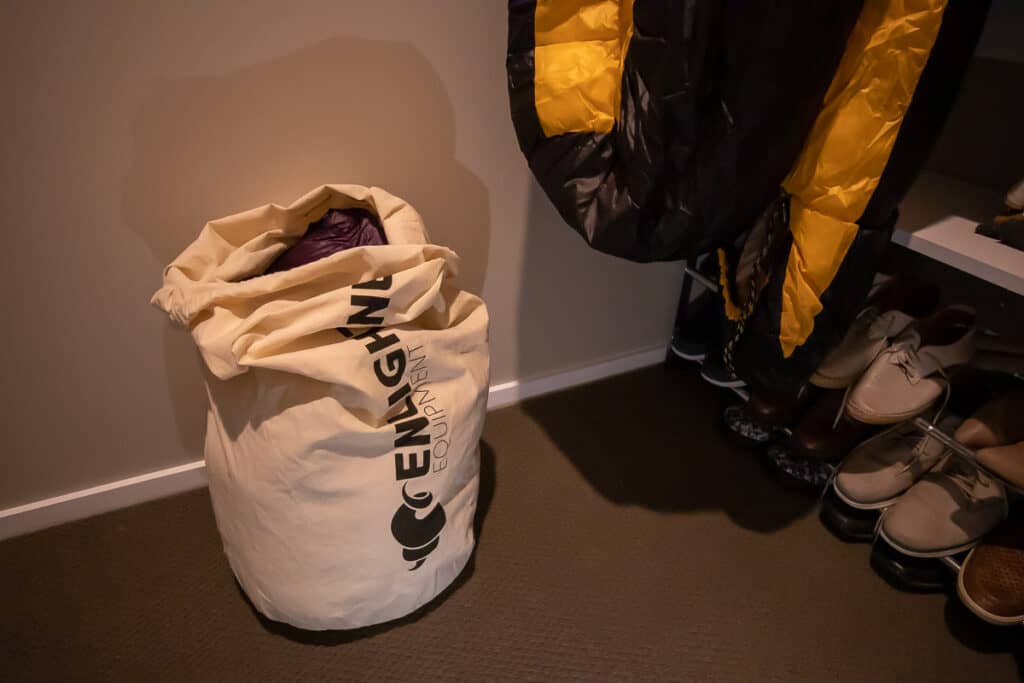
Find a container which is big enough to allow your bag to loft inside whilst in storage (there’s a suggestion at the end of this post).
Avoid containers which create an airtight seal, as the changes in temperature can cause air to condense inside and lead to mould.
Instead, opt for a container which can be easily ventilated, but still protects the bag from dust, dirt and vermin. If you only have a fully enclosed (plastic) container, you can crack the lid slightly to allow air to flow through.
The best place to store sleeping bags in a garage is an elevated shelf about half way between the floor and ceiling to avoid the worst temperature extremes.
How to Store Sleeping Bags in an Attic
As with garages, attics also suffer severe temperature fluctuations which can cause damage to your sleeping bag.
Again, avoid storing your sleeping bag in the attic if at all possible. But if unavoidable, follow the steps above to find a container for your sleeping bag which is ventilated but does not allow too much dirt or grime to enter.
The best place to store sleeping bags in an attic is close to the attic hatch or eaves where temperatures are slightly cooler due to air passing on the other side.
How to Store Sleeping Bags in a Basement
Basements are a common place to store sleeping bags, however they can be very damp places so mould might start to build up on your sleeping bag if it’s not stored properly.
If your basement is insulated with plenty of ventilation, you may be able to avoid any serious damage to your bag.
Again, follow the tips above for how to store a sleeping bag in a garage, and find a container which keeps the bag ventilated but does not let too much damp in.
A good tip here is to store the bag inside out, as waterproof coatings on the outer layer of a sleeping bag can create a barrier which prevents moisture inside the bag from escaping.
The best place to store sleeping bags in a basement is on a high shelf, because the hotter and drier air rises, whereas cool air (and damp) will fall to the floor.
Sleeping Bag Storage Containers.
If you’re looking for a storage container to store your sleeping bag in, I would recommend opting for one which is made of natural materials such as cotton or canvas.
Here are my recommendations for the best sleeping bag storage sacks.
⭐⭐⭐⭐⭐
Macpac Mesh Storage SackSpecifically designed for Macpac’s range of sleeping bags, but versatile enough to cater to other brands, this sack will fit most sleeping bags without taking up too much space in your closet. Measures 65cm x 30cm (23″ x 12″).
✅ Commercial Mesh Laundry Bag
Made from heavy duty commercial nylon, this mesh bag is designed to hold a week’s worth of laundry but makes an excellent substitute for a sleeping bag storage sack. With drawstring closure and at a large 90cm x 60xcm (36″ x 24″) you can be sure there’s plenty of room for your bag to spread out in this great storage container.
✅ Equinox Sleeping Bag Storage Sack
This breathable 100% cotton sleeping bag sack has a heavy duty drawstring and cord lock to keep your sleeping bag secure whilst in storage. In a long and narrow style measuring 86cm x 35cm (34″ x 14″), it will comfortably fit most sleeping bags, whether down or synthetic.
✅ Natural Cotton Laundry Bag
You can’t go past the trusty cotton laundry bag. This style is the largest of my picks here at 90cm x 70cm (36″ x 28″) providing the best down sleeping bag storage sack with the most space for your bag to loft and prolonging its life. The drawstring cinch top with cord lock is similar to other styles, and this is a great substitute if your sleeping bag didn’t come with its own cotton bag. Plus, you get two for the price of one!
✅ Sistema 60L Storage Organiser
Although not recommended unless in a pinch, if you absolutely have to store your sleeping bag in a plastic container then the Sistema 60L large organiser is the way to go. Featuring a stackable BPA-free design, this heavy duty storage box will keep your bag free of damaging dust and dirt in a harsh environment. TIP: crack the lid to prevent excessive moisture build up causing mould.
FAQs
Skimmed through this post, or still have questions? Here are some of the web’s most frequently asked questions about how to store a sleeping bag properly.
What is the best way to store sleeping bags?

The best way to store a sleeping bag is to loosely pack it into a cotton or mesh sleeping bag storage sack, which allows free flow of air. Pop it on a high shelf in a cool and completely dry cupboard or room for best ventilation. Avoid fully sealed containers as they can cause condensation inside leading to mould growth.
Can I store a down sleeping bag compressed?

No, you should not store your down sleeping bag compressed for a long period of time. Storing down sleeping bag compressed will cause it to lose loft and damage the delicate loose down fill fibres so that it becomes less effective at trapping air and providing warmth. Instead, store your sleeping bag loosely packed in a cotton or mesh sack to allow for free flow of air.
Should sleeping bags be stuffed or rolled?

Sleeping bags should be stuffed instead of rolled. Stuffed sleeping bags retain their shape and will maintain a loft, protecting their delicate fibres and fabrics and keeping them warm for longer. Storing sleeping bags rolled or folded can cause permanent damage to loose down fill insulation, reducing their effectiveness at trapping air and providing warmth. It can also cause the zips to buckle or bend into funny shapes, reducing the life of your zippers.
Should I fold my sleeping bag?

No, you should not fold your sleeping bag. Folding or creasing can cause damage to the delicate outer materials and insulation fibres that will gradually reduce its warmth and comfort. Instead, you should stuff your sleeping bag loosely into a large mesh or cotton bag or hang it over a hanger, and store it in a cool and dry place in your house.
Final Thoughts: How To Store A Sleeping Bag
The right storage solution can make a huge difference in the longevity of your sleeping bag. By following these sleeping bag storage hacks, you’ll be able to keep your sleeping bag warm and cozy for many years to come.
With proper care and maintenance, you can ensure that your sleeping bag remains a reliable part of your outdoor gear!
So next time you return home from camping or hiking, remember these tips on how to store a sleeping bag properly – it’s worth the effort!

